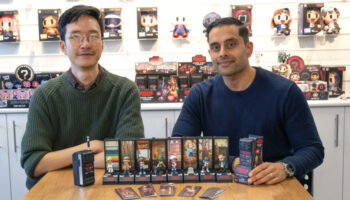Alley Cat Games’ Caezar Al-Jassar on the key to a fruitful designer/publisher relationship

Alley Cat Games is the Cambridge-based independent board game publisher behind an expansive line-up of tabletop titles, spanning Euro hits like Dice Hospital and Tungaru to mass market dexterity games like Kitten and Tinderblox.
We caught up with Caezar Al-Jassar, co-director and lead developer at Alley Cat Games, to find out how the company went from having an initial focus on science to now boasting a portfolio of games chock-full of everything from chocolate factories to dinosaur theme parks.

Hi Caezar. So, first off, your background pre-Alley Cat Games was in not in the tabletop space, but in science. Where did the seed of an idea to launch your own games company come from?
Yes, that’s right. When the spark all started, I was working as a postdoctoral fellow at the Laboratory of Molecular Biology, Cambridge. At the time, my wife and I started to design our first game; Lab Wars.
I had been given a card game prototype from my best friend’s brother – he actually ended up designing ITB’s hit smash, Sub Terra. We were on holiday in Spain at the time, and we were just getting into gaming and thought why not! My wife is a creative type and enjoyed the physicality of crafting a prototype ourselves.
It kind of spiralled from there, and Lab Wars featured in huge science outlets such as Nature News, Science and even The New York Times. It’s down to that publicity that we were able to launch Alley Cat Games as a company and I never looked back.

There’s been a science-theme to a few of your launches since, like Dice Hospital and Pocket Pharma. Was this a happy accident or was the initial plan to keep science at the heart of your games?
When Alley Cat Games first started, we initially intended to publish science only games. But it became quickly apparent that as a genre this was way too niche to work in, particularly as Genius Games already did something similar.
Instead, we quickly took the approach of “real world” themes which is much more broad, but at the same time still quite niche when you consider most games released remain fantasy-focused.

This approach seems to have paid off as many of our real world themes have resonated with hobby gamers, particularly those who wanted something fresh and different to the usual fantasy themes, which in themselves can be quite hard for a non-gamer to get into.
Absolutely, and looking across the Alley Cat Games portfolio, you’ve worked with a raft of different designers, of different experience-levels, and you’re known for being very inventor-friendly. Why is the designer community important to Alley Cat, and – great ideas aside – what is key to a fruitful partnership?
Yes that’s a really good question. Publishers are heavily reliant on designers bringing their games to them, so that they can pick the best games to publish.
Experienced designers, such as Brett J Gilbert and Matthew Dunstan have the “know-how” of what publishers are looking for both as a game design and product and therefore experience counts for a lot. However, it’s not to say that new inventors and designers should not try.
We were pitched an incredibly simple but brilliant mass market mint-tin dexterity game called Tinderblox from Rob Sparks, and he had never had a game published in his life; in fact, from recollection, that was his first game he ever pitched!

To keep relationships fruitful between designers and publishers, it has to be a two-way process, but also both have to not waste each others’ time. Countless designers have wasted our time by submitting something that is 100% clearly and demonstrably not what we ask for in our extremely comprehensive games submission form.
Conversely, we’ve signed up games with the full intention of publishing them, sat on them, and then through a strategy shift, had to give the game designs back. However, once games are signed up, it’s much easier on the relationship if both have constant discussions on the game design, any further playtesting, as well as designers offering to help with marketing and so forth.
There are so many facets to this relationship that I could go on for quite a while!
You mentioned your games submission form – which we’ll link to here – but for designers wanting to pitch concepts to you guys, what is your process for this?
It’s very similar to other publishers in the industry to be honest. Our main difference is off the bat, we are extremely clear about the type of games we are looking for on our games submission page. In fact, we make it so clear that many designers could look at the form and go: “Hey! I could design x game or y game!”.
Right now we have a three pronged approach to the games we are releasing and looking for in the future. Firstly: euro games like Dice Hospital and Chocolate Factory. Secondly: accessible, fun and unique mass market games, such as Kittin and Tinderblox, and thirdly: licensed games, such as our upcoming Simon’s Cat game: NOM!

Great, and before we let you go, do you think the tabletop space is in a good place from a creativity point of view at the moment?
Yeah, for sure. Despite the literally thousands of games being released each year in the hobby market alone, there are lots of gems in there that people thoroughly enjoy. From the game mechanics, to the physicality but also the theme and approach.
If you’ve got an idea, just jot it down on paper and get it to a physical form as quickly as possible!
Great advice! Thanks again Caezar; hopefully catch up soon!
—-
To stay in the loop with the latest news, interviews and features from the world of toy and game design, sign up to our weekly newsletter here

























